Essential Facts About Walk-In Body Refrigerators
When it comes to caring for the deceased with dignity and respect, having the right equipment makes all the difference. A walk in body refrigerator is much more than just a cooling unit – it's a specialized space designed specifically for preserving human remains with care and precision.
These purpose-built refrigeration systems serve as the backbone of funeral homes, morgues, and medical examiners' offices across the country. If you're considering one for your facility, here's what you should know:
| Feature | Details |
|---|---|
| Purpose | Preserves human remains through temperature control |
| Ideal Temperature | 34°F to 39°F (1°C to 4°C) |
| Standard Insulation | 4-inch foamed-in-place urethane (R-value of 28) |
| Typical Capacity | 4 to 50 bodies depending on configuration |
| Key Components | Specialized shelving, precise temperature control, vapor-proof lighting |
| Installation Needs | Adequate ventilation (5-6 air changes per hour), level flooring, dedicated electrical circuit |
| Energy Efficiency | 15-25% more efficient than older or lower-quality units |
I've spent years helping funeral professionals find the perfect balance in their refrigeration needs. What I've learned is that selecting the right walk in body refrigerator isn't just about technical specifications – though those are certainly important. It's about understanding how this equipment fits into your overall mission of providing compassionate, dignified care.
The best units maintain precise temperatures between 34°F and 39°F, creating the ideal environment to properly preserve remains while families make arrangements. With high-quality insulation and modern temperature controls, today's walk-in units offer remarkable consistency that older systems simply can't match.
Beyond temperature, capacity planning is crucial. Whether you need space for 4 bodies or 40, your refrigeration system should accommodate your current needs while allowing room for potential growth. Modern systems offer flexible configurations with specialized shelving that maximizes your available space.
Installation requirements matter too. Proper ventilation, level flooring, and dedicated electrical circuits aren't just recommendations – they're necessities for keeping your system running efficiently for years to come.
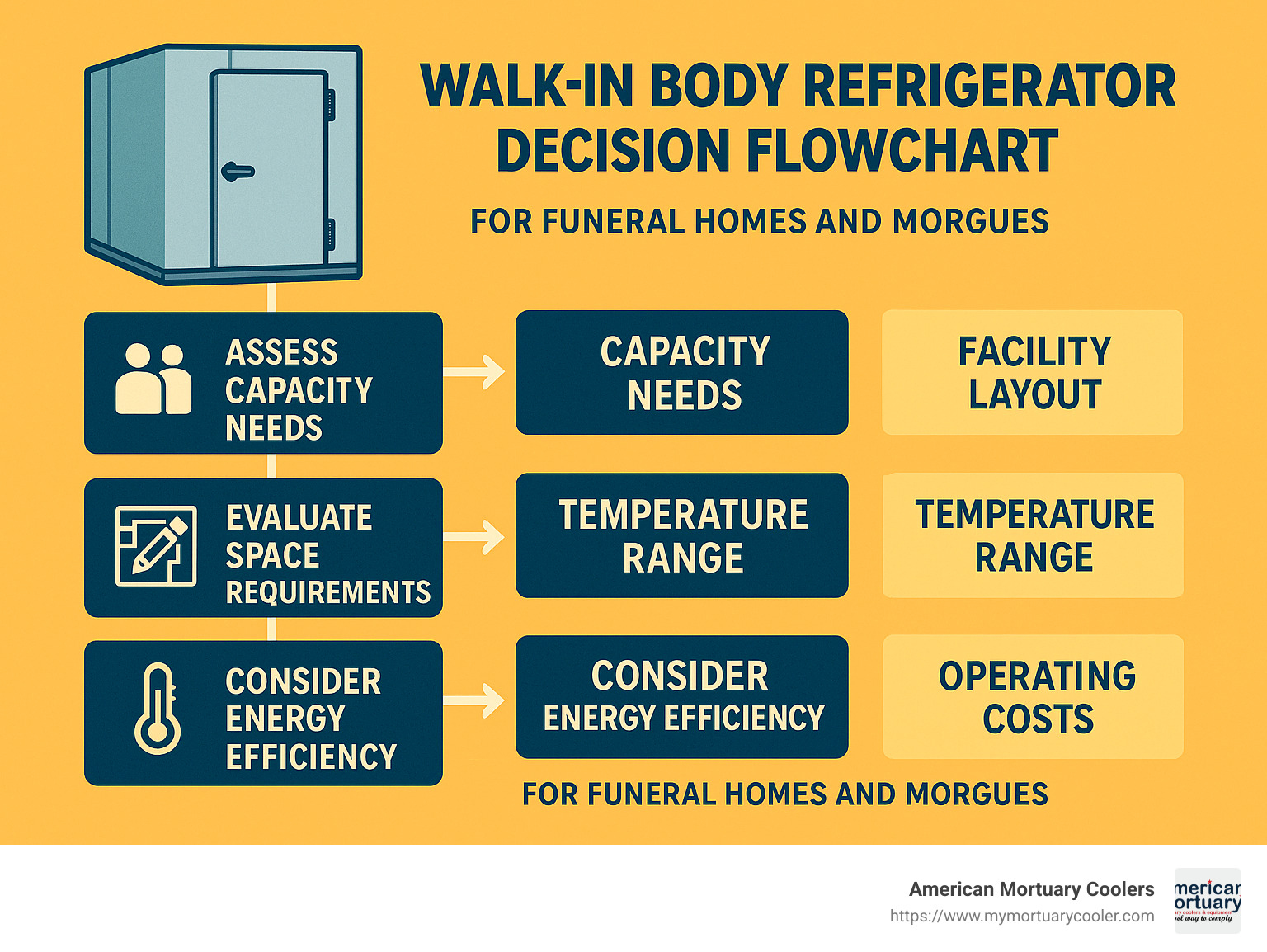
At American Mortuary Coolers, we understand that behind every technical detail is a human story. Our Tennessee-based team specializes in crafting custom walk in body refrigerator solutions that serve your practical needs while honoring your commitment to the families you serve. We deliver directly to funeral homes across the contiguous 48 states, ensuring you get exactly what you need without unnecessary complications.
Want to learn more about your refrigeration options? We've put together some helpful resources:
What Is a Walk in Body Refrigerator?
A walk in body refrigerator is essentially a specialized cold room designed specifically for preserving human remains with dignity and care. Unlike standard commercial refrigeration, these systems are thoughtfully engineered to meet the unique needs of mortuary science.
Here at American Mortuary Coolers, we see a walk in body refrigerator as more than just equipment—it's a temperature-controlled environment spacious enough for staff to move comfortably inside, featuring specialized body storage systems and precise temperature controls that respect both the scientific and human aspects of funeral care.
"When families entrust their loved ones to your care, having reliable refrigeration isn't just convenient—it's essential," as one of our funeral director clients recently shared with us.
These specialized units maintain temperatures between 34°F and 39°F (1°C and 4°C), the sweet spot for slowing decomposition without causing freezing damage to tissues. This carefully controlled environment preserves remains respectfully while giving funeral professionals the time needed to make proper arrangements and preparations.
Every quality walk in body refrigerator we build includes thick 4-inch insulated panels, dedicated high-efficiency compressors that know how to handle the unique cooling demands, body-specific storage racks, vapor-proof lighting for safety, digital temperature monitoring, and OSHA-compliant safety features throughout.
We design our walk-in units with prefabricated modular panels that snap together easily, allowing for simple assembly and the flexibility to expand as your needs grow. This adaptability is particularly valuable for growing funeral homes or facilities that experience seasonal fluctuations in their service demands.
A Practical Guide to Choosing a Walk-In Body Refrigerator
Walk in Body Refrigerator vs Standard Unit
It might be tempting to repurpose a standard commercial refrigerator, but there are meaningful differences that make purpose-built walk in body refrigerators the respectful choice for proper mortuary operations.
The 4-inch urethane panels in our mortuary units provide superior R-28 insulation value compared to the thinner 2-3 inch panels in commercial refrigerators. This makes a real difference in maintaining the precise 34-39°F temperature range (with just ±1° variation) that proper preservation demands.
Beyond insulation, our walk in body refrigerators feature body-specific racks with smooth-rolling systems for gentle, dignified handling. The OSHA-compliant safety door handles allow emergency exit from inside—a critical feature standard units typically lack. We also include non-slip flooring and surfaces specifically designed for biohazard management rather than just food-grade materials.
"We understand budget concerns," our manufacturing team often says, "but we can customize any unit to fit both your facility's needs and financial considerations without compromising on the essentials."
The purpose-built design addresses unique challenges in body preservation. The tighter temperature tolerances prevent the fluctuations that can accelerate decomposition, while the specialized shelving allows for dignified handling of remains in a way that honors both the deceased and their families.
Ideal Temperature Settings for a Walk in Body Refrigerator
The science of body preservation requires finding that perfect environmental balance. For a walk in body refrigerator, maintaining temperatures between 34°F and 39°F (1°C to 4°C) is absolutely critical.
This narrow range matters tremendously because temperatures above 39°F allow bacteria to flourish, accelerating decomposition processes and potentially compromising the dignity of the deceased. Conversely, temperatures below 34°F risk tissue freezing, which can damage remains and create complications for embalming procedures.
Our modern walk in body refrigerators at American Mortuary Coolers feature intuitive digital thermostats and advanced control systems that maintain this precise temperature band without constant adjustment. The digital LED control panels allow for fine-tuning in 0.5-degree increments, ensuring optimal preservation conditions with minimal staff intervention.
Humidity balance also plays a key role—too much promotes unwanted bacterial activity, while too little causes tissue dehydration. Our systems naturally maintain relative humidity between 85-90%, helping preserve remains in their most natural state.
As one satisfied mortuary professional told us recently: "The CoolBot and the 12000 BTU AC have been working great, keeping the cooler at 37 to 38 degrees F." That kind of reliability and consistency is exactly what proper preservation—and peace of mind—requires.
Feature, Capacity & Customization Checklist
When selecting a walk in body refrigerator, several key features will determine both its performance and suitability for your specific facility needs. At American Mortuary Coolers, we help funeral professionals steer these options to find the perfect configuration for their unique situation.
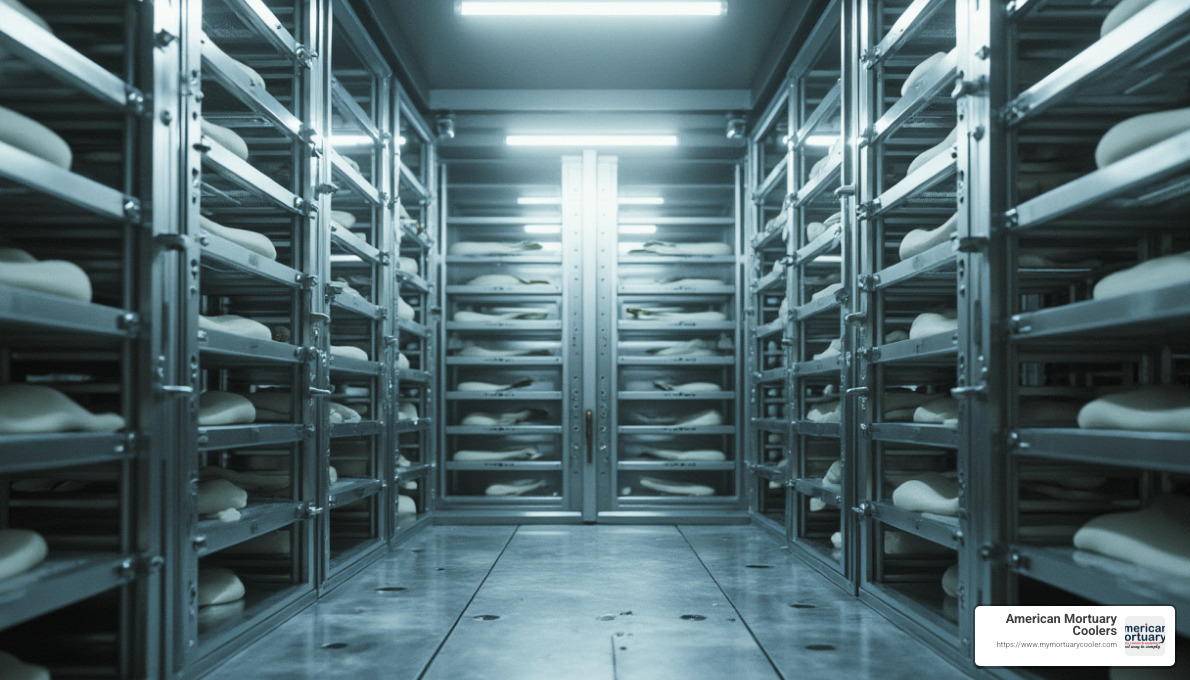
The foundation of any quality walk in body refrigerator starts with proper insulation. We recommend looking for units with 4-inch thick foamed-in-place urethane panels that provide an R-value of 28 or higher. This level of insulation isn't just about energy efficiency—it's essential for maintaining the stable environment needed for dignified preservation.
Inside your cooler, modular rack systems make all the difference. These adjustable configurations allow you to accommodate different body sizes while maximizing your available space. We've designed our racks to be easily accessible while providing secure support for remains of all sizes, including bariatric options for larger individuals.
"With coolers made to order, we recognize no two facilities are alike," explains our design team at American Mortuary Coolers. "What works for a busy urban funeral home might not suit a smaller rural operation."
Capacity planning is perhaps the most crucial decision you'll make. Our walk in body refrigerators range from compact units holding 4-5 bodies to large installations capable of storing 40-50 bodies. Many of our clients find that medium-sized units (10-20 capacity) offer the best balance of upfront cost and operational flexibility for suburban funeral homes.
Safety features aren't optional extras—they're essential components of a professional-grade walk in body refrigerator. OSHA-compliant safety release handles ensure staff can exit even if locked from outside, while non-slip flooring prevents accidents in potentially wet conditions. Our vapor-proof LED lighting systems provide energy-efficient illumination that's safe in high-humidity environments without generating excess heat.
Insulation & Energy Efficiency Essentials
The quality of insulation in your walk in body refrigerator directly impacts both performance and your monthly utility bills. This is one area where cutting corners can lead to significant long-term expenses.
Our walk-in units feature 4-inch thick foamed-in-place urethane insulation with an R-value of 28. This high-density insulation creates a thermal envelope that maintains precise conditions regardless of external temperature swings. It also reduces compressor runtime, minimizes condensation issues, and even helps dampen operational noise—creating a more respectful environment.
"While better insulation increases upfront costs, it pays off quickly in energy savings," our engineering team often explains to clients. In fact, a high-efficiency walk in body refrigerator can reduce electricity costs by 15-25% compared to older or lower-quality units, typically yielding a return on investment within 3-5 years.
The way panels connect matters too. Our cam-lock panel system creates airtight seals at all joints, eliminating thermal bridges that waste energy. This system also makes installation straightforward and allows for future expansion if your needs change—something many growing funeral homes appreciate.
Beyond insulation, we incorporate other energy-saving features like EC (Electronically Commutated) fan motors that use up to 30% less electricity than standard motors, LED lighting that consumes 75% less energy than fluorescent alternatives, and smart defrost cycles that activate only when needed.
Refrigeration Revelation: Walk-In Body Refrigerators Reviewed
Advanced Monitoring & Safety Features
Modern walk in body refrigerators do more than just maintain temperature—they actively monitor conditions and alert you to potential issues before they become problems.
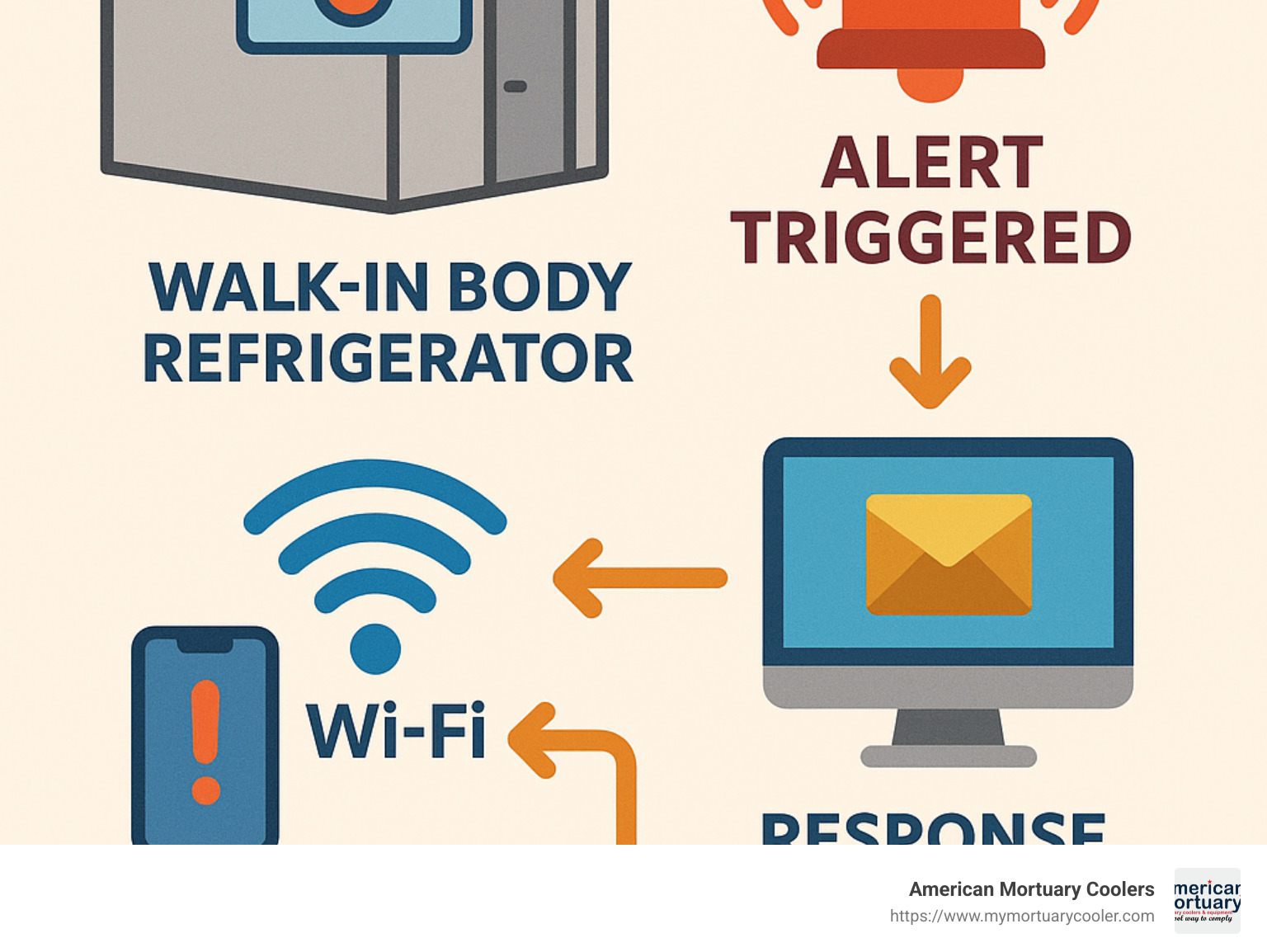
Our digital data logging systems record temperature readings at regular intervals, creating a verifiable record for compliance purposes. With WiFi connectivity, you can check conditions from your smartphone or computer, even when you're away from the facility. As one customer told us: "The CoolBot Pro temperature alerts via WiFi have been a game-changer. I can monitor conditions from anywhere and receive immediate notifications if there's an issue."
Safety isn't just about technology—it's about peace of mind. That's why we include antimicrobial surface treatments on high-touch areas, emergency lighting systems that illuminate the interior during power failures, and UPS backup systems that maintain critical functions temporarily during outages.
For facilities with specific security concerns, we can integrate CCTV systems that provide visual monitoring of the refrigerator interior and access control systems that log entry/exit while restricting unauthorized access. These features not only improve security but also simplify compliance with health department regulations and accreditation requirements.
Sizing Your Unit & Planning for Growth
Determining the right size for your walk in body refrigerator requires balancing current needs with future growth. It's a conversation we have with every client, helping them develop long-term solutions that make financial sense.
Start by considering your current maximum capacity—how many bodies do you typically need to store during your busiest periods? Then think about growth projections for the next 5-10 years. Will your community be expanding? Are you planning to offer new services? These factors all influence the ideal size of your unit.
Space planning goes beyond just the number of bodies. Each body requires approximately 24" × 80" of rack space, but you'll also need sufficient aisle width (typically 36-48") for dignified handling. The configuration of your racks—whether single, double, or triple-tier systems—dramatically affects how much floor space you'll need.
"We've helped many funeral homes maximize their available space without compromising on capacity or dignity," shares our design team. Our modular panel system is particularly valuable because it allows for future expansion without replacing the entire unit. Many clients choose to install a slightly larger refrigeration system initially, positioning the unit where additional panels can be added later as their needs grow.
For facilities with tight space constraints, we offer innovative solutions like compact designs with telescoping racks that extend only when needed, pass-through configurations that serve multiple preparation rooms, and custom shapes that effectively use irregular spaces.
Maximize Space with Indoor Walk-In Coolers
Installation, Maintenance, Compliance & ROI
Setting up your walk in body refrigerator isn't just about getting it through the door—it's about creating a solution that works flawlessly for years to come. Let's walk through what you need to know about proper installation, keeping your unit running smoothly, and making sure your investment pays off in the long run.
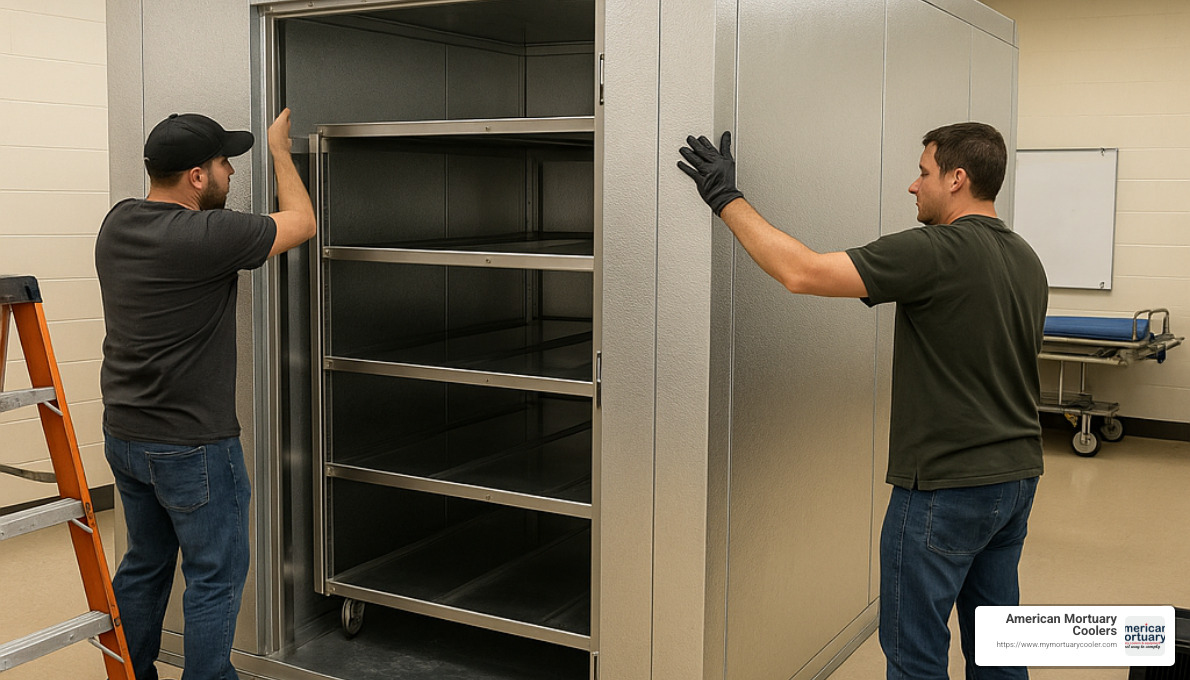
When planning for installation, you'll need to consider several practical factors. First, make sure you have enough space—not just for the unit itself, but also for proper door clearance and ventilation around the system. Good airflow is crucial, with 5-6 air changes per hour recommended to prevent any odor buildup (something your staff will definitely appreciate).
Most of our walk in body refrigerators require a dedicated 208-230V electrical circuit, so you may need to consult with an electrician before installation day. Your flooring also needs attention—it should be perfectly level and strong enough to support about 700 pounds per square foot. That might sound excessive, but when you consider the weight of the unit, racks, and multiple bodies, it adds up quickly!
"I always tell clients to think about the whole journey," says one of our installation specialists. "Can the unit actually make it to its final destination? Are your doorways wide enough? Will it fit in the elevator? These simple questions can save major headaches on delivery day."
Compliance isn't optional in our industry. Your walk in body refrigerator needs to meet Federal Energy Independence & Security Act standards, OSHA safety requirements, local health department regulations, and have the proper NSF/UL certifications. Don't worry—our units are designed with these requirements in mind, but it's always good to double-check local codes before installation.
The good news is that investing in quality pays off. A properly installed and maintained unit from American Mortuary Coolers typically delivers 15-25% energy savings compared to older models. With fewer breakdowns and a lifespan of 15-20 years, the long-term value becomes clear. Plus, the peace of mind that comes from knowing you're fully compliant with all regulations? Priceless.
Recommendations for Corpse Refrigeration Applications
Step-by-Step Installation Checklist
Installing a walk in body refrigerator isn't a DIY weekend project, but understanding the process helps ensure everything goes smoothly when our team arrives.
Before we ever show up with panels and tools, there's important groundwork to be done. We'll help you assess your site, making sure the floor is level and identifying the best access routes. We'll verify that your electrical service can handle the load and that ventilation is adequate. We'll also guide you through any permit requirements and coordinate delivery timing to minimize disruption to your operations.
When installation day arrives, our team follows a carefully choreographed process. First, we prepare the floor, installing a vapor barrier if needed to prevent moisture issues. Then comes the assembly of the wall and ceiling panels—these fit together with precision using our cam-lock system. The doors are carefully mounted and aligned to ensure proper seals, followed by installation of the refrigeration system, electrical connections, and rack system.
"The moment of truth is always the testing phase," one of our senior installers likes to say. "When we fire up that system for the first time and watch the temperature drop steadily to exactly where it should be—that's when we know we've done our job right."
| Floor vs. Floorless Builds | Advantages | Considerations |
|---|---|---|
| With Floor | Complete vapor barrier, Simplified installation, Portable if needed | Higher initial cost, Step-up threshold, Potential for damage during loading |
| Floorless | Lower cost, No threshold to cross, Integration with existing floor | Requires insulated floor in concrete, Potential for vapor issues if not properly sealed, Less flexible for future relocation |
For most funeral homes, the floorless option works best when you have a properly prepared concrete floor. This eliminates the threshold that staff would otherwise need to steer when moving bodies in and out.
After everything is installed, we don't just hand over the keys and walk away. Our commissioning process includes careful temperature calibration, thorough testing of all door seals, programming of control systems, and hands-on training for your staff. We want everyone to feel comfortable operating the unit from day one.
For clients in remote locations, we offer detailed guides and remote support, but we strongly recommend professional installation. Not only does it ensure everything works correctly, but it also protects your warranty—giving you one less thing to worry about.
Routine Maintenance That Extends Life Span
Think of your walk in body refrigerator like a quality car—regular maintenance isn't just recommended, it's essential for longevity. With proper care, these units can serve your facility faithfully for 15-20 years.
Daily attention pays big dividends. Make checking and logging the internal temperature part of your morning routine—it takes just seconds but can catch potential problems early. While you're there, scan for any condensation, ice buildup, or door seal issues. A quick wipe-down of interior surfaces with appropriate sanitizers keeps everything clean and prevents odor development.
Weekly maintenance goes a bit deeper. This is the time for thorough sanitization of all interior surfaces with approved disinfectants. Check those door gaskets carefully—they're the frontline defense against temperature fluctuations and energy waste. Make sure the condensate drain is flowing freely too; a clogged drain can create moisture issues that compromise the unit's efficiency.
"The condensate drain is the unsung hero of your cooler," our maintenance director often reminds clients. "It's easy to forget about until it's clogged, and then you've got a real problem on your hands."
Monthly tasks include checking the evaporator for ice buildup, tightening any loose hardware on hinges, handles, and rack mounts, and testing your alarm systems. Quarterly, you'll want to clean those condenser coils (dust is the enemy of efficiency!), check refrigerant levels, and inspect all electrical components.
Once a year, it's worth having our professionals perform a comprehensive evaluation. We'll tune the refrigeration system for optimal efficiency, calibrate all controls, and identify any components that might need attention before they fail.
Keeping a detailed maintenance log isn't just good practice—it's essential documentation. Record dates, conditions, actions taken, parts replaced, and who performed the work. This simple habit proves compliance for regulators, helps identify patterns that might signal developing issues, and supports warranty claims if needed.
At American Mortuary Coolers, we offer maintenance contracts that give you peace of mind with scheduled professional service, priority emergency response, and discounted parts. It's like having insurance for one of your facility's most critical pieces of equipment.
Calculating Total Cost of Ownership
When investing in a walk in body refrigerator, the sticker price is just the beginning of the story. Smart funeral directors look at the total cost of ownership (TCO) to make truly informed decisions.
Your initial investment includes more than just the base unit. There's customization to fit your specific needs, delivery to your location, professional installation, and sometimes site preparation. While it might be tempting to cut corners here, quality components and professional installation typically pay for themselves many times over.
"I've seen funeral homes try to save a few thousand upfront, only to spend double that amount in extra energy costs and repairs over the next five years," shares our financial advisor. "That's not savings—that's just delaying payment with interest."
The day-to-day costs of running your unit include energy consumption (typically 30-50 kWh per day depending on size), routine maintenance, cleaning supplies, occasional repairs, and potentially even impacts on your facility insurance. These ongoing expenses add up over time and can vary significantly based on the quality of your initial purchase.
Looking long-term, consider the expected 15-20 year lifespan of a quality unit, warranty coverage details, depreciation for tax purposes, potential resale value, and whether the unit can be upgraded rather than replaced as technology advances.
To put this in practical terms, a $25,000 walk in body refrigerator with annual operating costs of $2,000 over 15 years and a $2,000 end value would have a total cost of ownership around $53,000. That breaks down to roughly $3,533 per year or $294 monthly—quite reasonable when you consider the essential service it provides to your operation.
At American Mortuary Coolers, we can help you develop a detailed TCO projection based on your specific facility and needs. We believe in transparency because we know our quality units deliver better long-term value, even if the initial investment is higher than budget alternatives.
This isn't just any purchase—it's an investment in your ability to provide dignified care, maintain compliance, and operate efficiently for years to come. When you look at it that way, quality isn't expensive—it's priceless.
Frequently Asked Questions about Walk-In Body Refrigerator
What capacity range should I choose?
Choosing the right size for your walk in body refrigerator doesn't need to be complicated, though it is one of the most common questions we hear from funeral directors.
For smaller funeral homes handling around 100 cases per year, a 4-6 body capacity unit typically works well. You'll want to think about your busiest times of year and make sure you have enough space to handle those peak periods without stress. If you serve a diverse community, I always recommend including at least one bariatric position even in smaller units.
"We recently installed a 6-body unit for a rural funeral home," shares one of our installation specialists. "They were initially considering something smaller, but after discussing weekend coverage needs and holiday surges, they realized the extra capacity gives them valuable peace of mind."
Medium-sized operations handling between 100-300 cases annually generally benefit from 8-12 body capacity. This sweet spot provides the flexibility to handle unexpected situations while ensuring you're not investing in space you rarely use. Many of our clients in this range appreciate having separate areas for different preparation stages.
Larger facilities serving over 300 families each year typically require 16+ body capacity. The good news is our modular designs allow you to expand as your needs grow, so you're never locked into your initial decision.
A helpful rule of thumb I share with funeral directors: take your average daily census during your busiest month and multiply by 1.5. This buffer allows for those unexpected situations we all encounter in this profession.
This is about serving families with dignity while managing your resources wisely. We're happy to walk through your specific situation to find the perfect balance.
How do I meet health & safety regulations?
Navigating the regulatory landscape for walk in body refrigerator installations can feel overwhelming, but I promise it's manageable with the right approach.
Temperature control stands at the heart of compliance. Your unit must maintain consistent temperatures between 34°F and 39°F (1°C to 4°C), with daily documented readings. Modern units include alarm systems that alert you to any temperature fluctuations before they become problems. We also recommend having backup power plans in place – something that's become increasingly important with extreme weather events affecting power grids nationwide.
"When the ice storm hit last winter, our backup generator kept our walk-in at perfect temperature while the rest of the building was without power for three days," one funeral director in Michigan told us recently. "That preparation made all the difference for the families we were serving that week."
The materials used in your walk in body refrigerator matter too. Health inspectors look for NSF-approved food-grade materials for all interior surfaces that can be easily cleaned and sanitized. Proper drainage is essential both for cleaning and handling condensate.
Don't forget about ventilation – proper air exchange (5-6 air changes hourly) prevents odor buildup and creates a better working environment for your staff.
Documentation might not be the most exciting part of running a funeral home, but keeping organized records of maintenance, temperature logs, cleaning schedules, and staff training can save tremendous headaches during inspections. We provide our clients with simple templates that make this process painless.
At American Mortuary Coolers, we design all our units to meet or exceed regulatory standards across all 50 states. We're also happy to help you understand your specific local requirements – just let us know where you're located, and we can provide guidance custom to your jurisdiction.
Can I customize racks, doors, and finishes?
Absolutely! Creating a walk in body refrigerator that perfectly fits your facility's needs and aesthetic is one of the things we enjoy most at American Mortuary Coolers.
When it comes to rack systems, you have plenty of options. Some funeral homes prefer simple fixed racks, while others need the convenience of roller or telescoping designs that make transferring remains easier on staff. We offer single, double, or triple-tier configurations to maximize your space efficiency, and can create custom solutions for bariatric needs or special situations.
Doors are another area where customization makes a real difference in daily operations. Beyond standard 36" doors, we offer wider options up to 48" for easier bariatric access. Many clients choose pass-through designs that allow access from two different rooms – perfect for separating preparation areas from viewing rooms.
"The pass-through cooler has transformed our workflow," shares a funeral director from Tennessee. "We can prepare remains in our embalming room, then transfer directly to our visitation preparation area without moving through public spaces. Families appreciate the seamless experience."
The finishes you select contribute both to functionality and appearance. Interior options range from standard white aluminum to premium stainless steel or specialized antimicrobial coatings. For exterior finishes, we can match practically any décor – from classic wood grain to modern powder-coated steel in your choice of colors.
Lighting and control systems are worth considering too. Our standard vapor-proof lighting works perfectly for most installations, but improved LED systems provide better color rendering that many preparation specialists prefer. Control systems range from simple digital displays to advanced touchscreens with remote monitoring capabilities.
The customization process starts with a conversation about your specific needs. We'll develop detailed specifications based on your input, create drawings for your approval, and then craft your walk in body refrigerator to those exact specifications. This collaborative approach ensures you'll receive exactly what you need to serve families with dignity and efficiency.
You're creating a system that your staff will use every day for years to come – it's worth taking the time to get the details right. We're here to help you steer those choices with our decades of experience.
Conclusion
Selecting the right walk in body refrigerator is a significant decision that impacts your facility's operations, energy consumption, and ability to provide dignified care. At American Mortuary Coolers, we understand that this equipment represents more than just a refrigeration unit—it's an essential component in your service to families during their most difficult times.
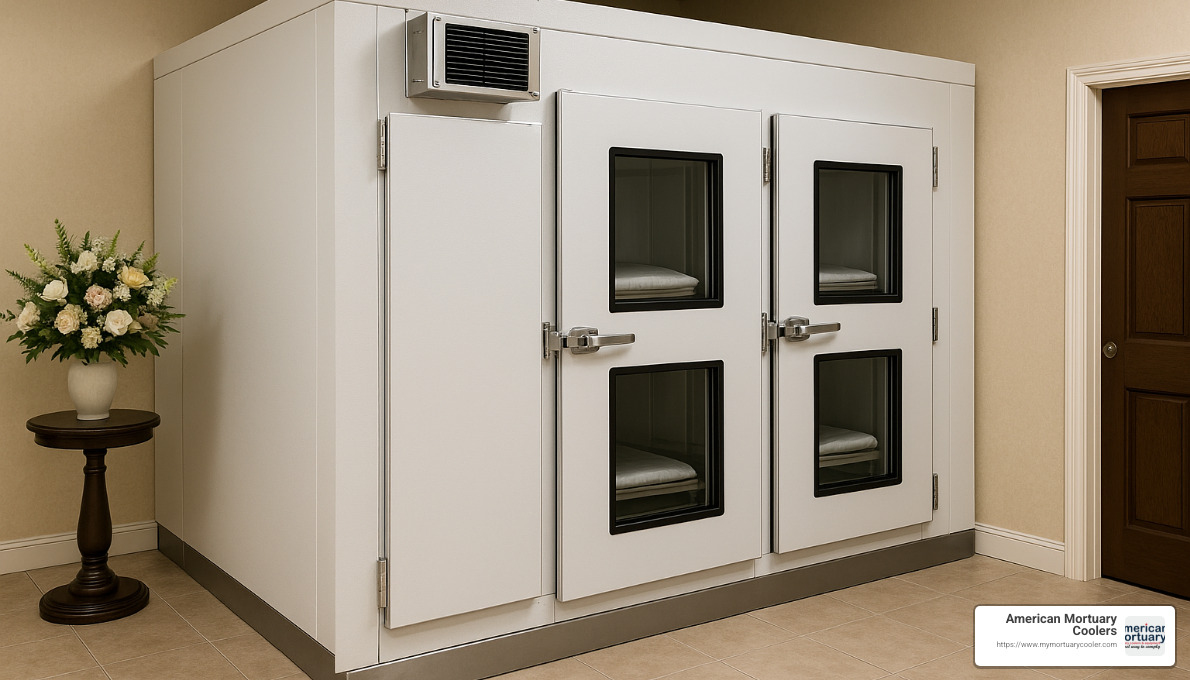
Throughout this guide, we've explored the critical aspects of mortuary refrigeration. We've seen how purpose-built design makes all the difference in preserving remains with dignity. The specialized construction ensures proper preservation while facilitating respectful handling—something that standard commercial units simply can't match.
Temperature precision isn't just a technical detail—it's the foundation of proper preservation. Maintaining that sweet spot between 34°F and 39°F slows decomposition without causing tissue damage, giving you the time needed to provide thoughtful preparation services. This precision is something we take seriously at American Mortuary Coolers.
When it comes to insulation, quality truly pays dividends. Those 4-inch foamed-in-place urethane panels with R-28 value might seem like an unnecessary expense initially, but they significantly reduce your operating costs over the life of the unit. Think of it as investing in peace of mind and long-term savings rather than cutting corners.
Looking ahead matters too. We've helped countless funeral directors who initially purchased units that were too small, only to find themselves struggling with capacity issues a few years later. By considering both current needs and future growth when sizing your unit, you'll avoid costly upgrades down the road.
Customization isn't just about aesthetics—it improves workflow and efficiency. When your refrigeration system is custom to your specific facility, everything works more smoothly. Your staff will appreciate thoughtful details like properly positioned racks and well-designed access points that make their daily tasks more manageable.
"The confidence that comes from knowing your equipment won't let you down when families need you most—that's what we're really providing," shares our service director. This reliability allows you to focus on what truly matters—serving families with compassion and professionalism during life's most difficult transitions.
Based in Tennessee with locations across the United States, American Mortuary Coolers specializes in crafting walk in body refrigerator solutions custom to the unique needs of each facility we serve. We're not just selling equipment—we're partnering with you to improve the care you provide. Our direct delivery across the contiguous 48 states ensures your equipment arrives safely and efficiently, without the complications of third-party shipping.
Whether you're building a new facility, replacing aging equipment, or expanding your current capabilities, we're here to help you steer the selection process with friendly guidance and personalized service. We understand that behind every technical specification is a family needing compassionate care, and we never lose sight of that human element.
For more information about our premier walk-in refrigerators and how we can help you serve families with the compassion, respect, and dignity they deserve during life's most difficult transitions, please reach out today. We're real people who care about your success, not just another equipment vendor.


















